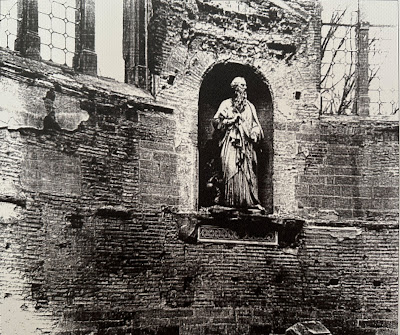There were actually three exhibitions: one in the Museum am Dom, a second in the Stadtmuseum Simeonstift, and a third in the Rheinisches Landesmuseum. I gave a talk and wrote a report about the trip, which I posted on the Internet.
From the 10th to the 12th of November, the Museumsgesellschaft traveled again to Trier for an exhibition, this time about the fall of the Roman Empire again in three museums.
The Museum am Dom presented Im Zeichen des Kreuzes (In the Sign of the Cross), a presentation on the role of
Christianity. The Stadtmuseum showed Das Erbe Roms (The
Legacy of Rome), highlighting the Empire's impact on art and history. The Landesmuseum gave a global overview of Der Untergang des Römischen Reiches (The Fall* of the Roman
Empire), i.e., the disintegration of the Roman Empire in the first centuries AD.
*Fall is an exaggerated, misleading term
Before I report on the visit, I summarize some small items in splinters, as usual.
Trier was an important city when it became one of four imperial residences in the late Roman time. Later, in the Holy Roman Empire, it was the seat of the Archbishop of Trier, one of seven members of the electoral college choosing the German emperor.
Trier during the centuries. From the Porta Nigra to Karl Marx
The most famous ancient building of Trier is the Porta Nigra built in the year 170.
Before I report on the visit, I summarize some small items in splinters, as usual.
Trier was an important city when it became one of four imperial residences in the late Roman time. Later, in the Holy Roman Empire, it was the seat of the Archbishop of Trier, one of seven members of the electoral college choosing the German emperor.
Trier during the centuries. From the Porta Nigra to Karl Marx
The most famous ancient building of Trier is the Porta Nigra built in the year 170.
Karl Marx is the most famous man born in Trier, but it was not until his 200th birthday that a monument was erected for the son of the city. It was a gift of China the city accepted apparently half-heartedly. The statue stands secluded near Porta Nigra and away from the pedestrian flow of the city center.
The 11th in the 11th at 11 o'clock 11

|
|
The Elferrat (11 councilors) on stage or eleven costumed fools count down the time |
The Constantine Basilica

|
| The vast interior captivates every visitor. |

|
| The Roman Aula |

|
| The "Basilica" in the Middle Ages |
Our bus returned to Freiburg at noon on Saturday, 12. So, Red Baron used the morning to explore the building complex of the Trier Cathedral.
Ausonius
On my way there, I passed a booth where students from Ausonius Elementary School were selling cakes. Who is this Ausonius?
This time, it was not a saint but a Roman scholar who originated from Bordeaux. Emperor Valentinian ordered him to Trier in 364 to teach his son, the future emperor Gratian.
The story is reminiscent of Goethe, whom Princess Amalia summoned to the court of Weimar to educate her son.
The Trier Cathedral
 |
| Christmas market installations blocked the view of the Romanesque facade |
The three-nave basilica's facade still presents itself in its original form.
The cloister is impressive just because of its sheer size.
Illustrated explanations of the cathedral's history, including the description of the Heiliger Rock (Seamless robe of Jesus), hang there.
Church of Our Lady
Next door to the cathedral is the impressive Liebfrauenkirche (Church of Our Lady).
At the entrance, the usual juxtapositions of Adam and Eve, Peter with his fishing net and John the Evangelist with a snake in the chalice, the triumphant Church, and the blindfolded Synagogue, i.e., Jews don't "see" Christ as the Messiah.
A Pieta in the entrance hall.
BMW Isetta
On my way back to the hotel, I saw a BMW Isetta, which was also known as an elephant foot in the vernacular. BMW produced the Isetta in the fifties of the last century.
Burgeramt
The words Burger and Bürger become interchangeable in German. Remember the delicious Freiburgers offered downtown Freiburg. In Trier, Red Baron came across a fast-food restaurant named Burgeramt. In Freiburg, the administrative office for citizens is called Bürgeramt.
*


















No comments:
Post a Comment